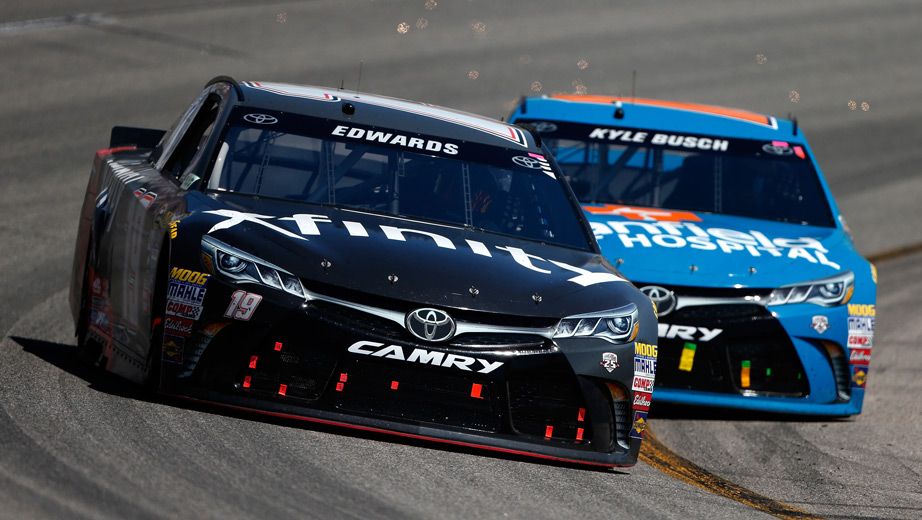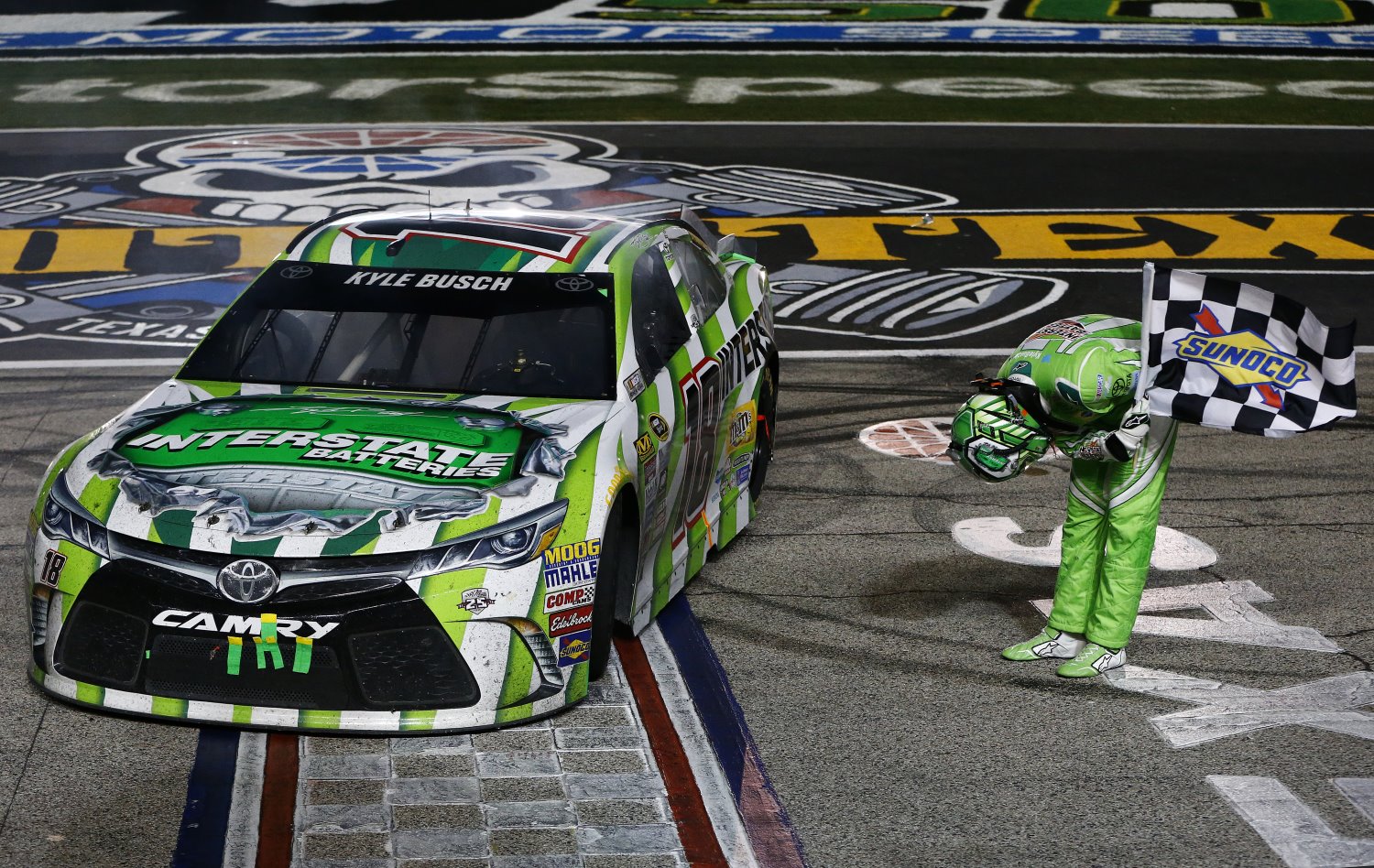Are new rules aimed to slow Joe Gibbs Racing?
 |
| JGR drivers – Edwards leads Busch |
When rule changes happen in the Sprint Cup Series, one of the first assumptions often is over whether NASCAR has created rules to snatch the advantages belonging to those dominating the circuit and bring them back toward the pack.
But Joe Gibbs Racing drivers don't have any such worries with recent NASCAR rule tweaks, and those trying to catch them won't go all that far in saying the new rules implemented in the past month will erase the advantage JGR drivers and Kevin Harvick have appeared to have in 2016.
"I don't think the rules are designed to level the playing field as much as they are designed to slow down the pace of the field just a tiny bit and again reduce the aerodynamic wake that makes it hard to pass," Team Penske driver Brad Keselowski said. "Everyone feels it is going to be good for the racing.
NASCAR has altered rules as far as requiring certain sizes of air ducts as well as a suspension weld rule and an electric cooling fan rule to eliminate ways teams have increased downforce. The changes come after NASCAR took away about 25 percent of their downforce with rule changes before the start of 2016.
The NASCAR Sprint Cup Drivers Council as well as the technical advisory committee — which consists of executives from Joe Gibbs Racing (Jimmy Makar), Hendrick Motorsports (Doug Duchardt) and Team Penske (Travis Geisler), giving each manufacturer one representative — consulted with NASCAR and the garage on the rules changes.
"We're all trying to reduce corner speeds," said Denny Hamlin, who sparked the creation of the drivers council last year. "Obviously with the downforce that was taken away in the offseason, what you don't see is what's happening behind the scenes, and that is that teams are getting smarter.
"If we had qualifying [last] weekend at Dover, there's a chance we would set another track record. While track records are fun and cool for the stat sheet, they're terrible for racing. We've got to slow these cars down. All groups recognize that."
Harvick, a member of the council, has led more laps (668) than any other driver this year. He is followed by JGR drivers Kyle Busch (679) and Carl Edwards (653), JGR affiliate Furniture Row Racing driver Martin Truex Jr. (417) and then JGR's Matt Kenseth (398). JGR has won seven of the first 12 races and Harvick has one. Hendrick and Penske have two wins apiece.
"From a council standpoint, we're all pushing … to keep the downforce off the cars," Harvick said. "The teams are just rapidly gaining on the downforce and sideforce. Everybody wants to see that reduced."
Busch oozes with confidence that his organization can adapt to any rule. The Sprint All-Star Race on Saturday will test a rule requiring no rear skew, which has forced teams to build or install new rear-end housings for the cars. The rule could be implemented for select tracks later this year and possibly virtually all tracks in 2017.
"It's only going to make JGR stronger because all these drivers are really, really good," Busch said about the rules changes. "We all have really good feel for our race cars, and we are all really good at what we do, and it brings out the best in drivers."
 |
| Kyle Busch wins Texas |
When JGR struggled in 2014 and the start of 2015, it put itself in position to thrive when rules change, Busch said.
"When we were behind on the engine side, we worked on our cars, we worked on our setups, we worked on driver-crew chief communications, all that stuff to get our cars better, and when the engines came, then it was all there," Busch said.
"We had the total package. We've been able to take advantage of all that the past couple of years, having all the right pieces in places."
Edwards joined JGR last year, and he conceded last year that he wondered which aerodynamic package would be best for JGR as NASCAR tried three packages during the 2016 season.
"Last year, when I was just getting into JGR and NASCAR was running all these different downforce packages, I was really concerned because I thought there has got to be one of these that we want way more than the others," Edwards said. "And one of the head technical guys looked at me and said, 'It doesn't matter what package we have. We're going to work hard and we're going to win races.'
"That attitude is what drives us. Everybody at JGR is fine with whatever rules we have to run under. Our strength is our people and our processes. It's neat to be part of a team like this."
The teams likely will have to look at new areas to create downforce other than those now eliminated by tweaks in the rules. So all those "technical guys" likely will be working hard in the next few weeks running experiments — both away from the track and at the track. Those drivers with wins could run experimental setups to see what works.
"You can go find another category to develop, but you'll never get these back," Keselowski said about the areas affected by the rules changes.
In addition to aerodynamic changes, don't forget about alterations to the lug nut rules, with NASCAR now requiring all five to be secured to each wheel in a "safe and secure" manner. Some viewed the lug nut rule changes as ones that will slow the JGR pit stops.
Busch has some advice for the competition if they want to catch JGR — it's not about trying to get the team to hit five lug nuts on every pit stop. The 2015 Sprint Cup champion was without his crew chief after the team was found to have only four lug nuts tight on his race-winning Kansas car.
"[The scrutiny] is just a huge part of other people not necessarily looking for things that they can do better. They're just looking to be complainers and try to slow us down," Busch said.
"When we were all behind in 2014, we weren't complaining about our competition beating us; we were complaining in our drivers meetings about why we were slow and what we needed to do to get better. And look at where we are now." Bob Pockrass/espn
